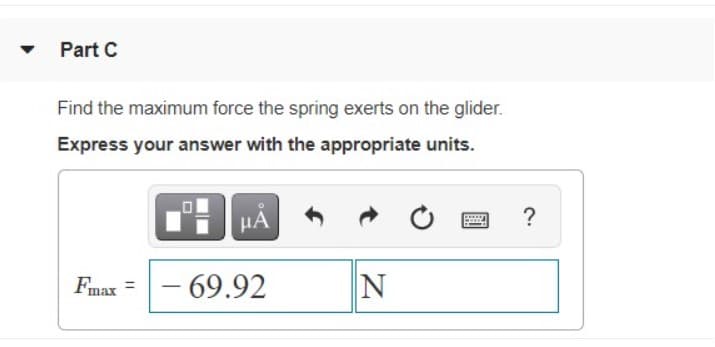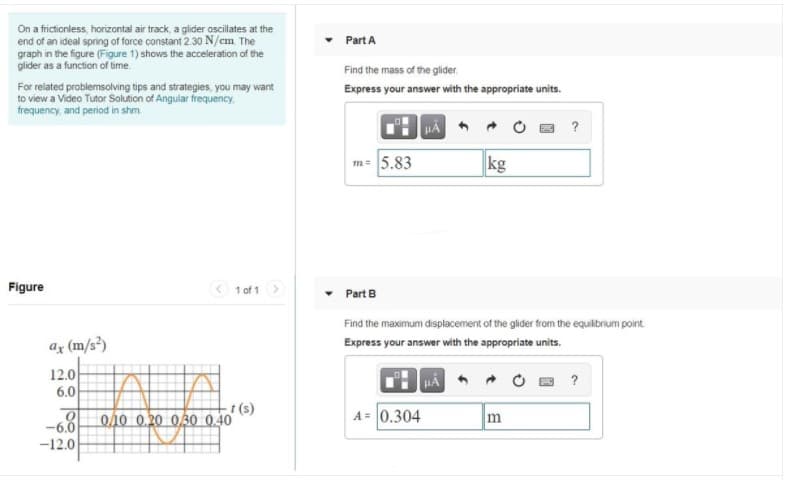Classical Dynamics of Particles and Systems
5th Edition
ISBN:9780534408961
Author:Stephen T. Thornton, Jerry B. Marion
Publisher:Stephen T. Thornton, Jerry B. Marion
Chapter12: Coupled Oscillations
Section: Chapter Questions
Problem 12.4P: Refer to the problem of the two coupled oscillators discussed in Section 12.2. Show that the total...
Related questions
Topic Video
Question

Transcribed Image Text:Part C
Find the maximum force the spring exerts on the glider.
Express your answer with the appropriate units.
Fmax =
- 69.92
N

Transcribed Image Text:On a frictionless, horizontal air track, a glider oscillates at the
end of an ideal spring of force constant 2.30 N/cm The
graph in the figure (Figure 1) shows the acceleration of the
glider as a function of time.
Part A
Find the mass of the glider.
For related problemsolving tips and strategies, you may want
to view a Video Tutor Solution of Angular frequency,
frequency, and period in shm
Express your answer with the appropriate units.
?
m= 5.83
kg
Figure
1 of 1>
Part B
Find the maximum displacement of the glider from the equilibrium point.
az (m/s³)
Express your answer with the appropriate units.
12.0
?
6.0
t (s)
0/10 0.20 030 0.40
A = 0.304
-6.0
-12.0
Expert Solution
This question has been solved!
Explore an expertly crafted, step-by-step solution for a thorough understanding of key concepts.
This is a popular solution!
Trending now
This is a popular solution!
Step by step
Solved in 4 steps with 6 images

Knowledge Booster
Learn more about
Need a deep-dive on the concept behind this application? Look no further. Learn more about this topic, physics and related others by exploring similar questions and additional content below.Recommended textbooks for you

Classical Dynamics of Particles and Systems
Physics
ISBN:
9780534408961
Author:
Stephen T. Thornton, Jerry B. Marion
Publisher:
Cengage Learning

University Physics Volume 1
Physics
ISBN:
9781938168277
Author:
William Moebs, Samuel J. Ling, Jeff Sanny
Publisher:
OpenStax - Rice University

Principles of Physics: A Calculus-Based Text
Physics
ISBN:
9781133104261
Author:
Raymond A. Serway, John W. Jewett
Publisher:
Cengage Learning

Classical Dynamics of Particles and Systems
Physics
ISBN:
9780534408961
Author:
Stephen T. Thornton, Jerry B. Marion
Publisher:
Cengage Learning

University Physics Volume 1
Physics
ISBN:
9781938168277
Author:
William Moebs, Samuel J. Ling, Jeff Sanny
Publisher:
OpenStax - Rice University

Principles of Physics: A Calculus-Based Text
Physics
ISBN:
9781133104261
Author:
Raymond A. Serway, John W. Jewett
Publisher:
Cengage Learning

Physics for Scientists and Engineers: Foundations…
Physics
ISBN:
9781133939146
Author:
Katz, Debora M.
Publisher:
Cengage Learning